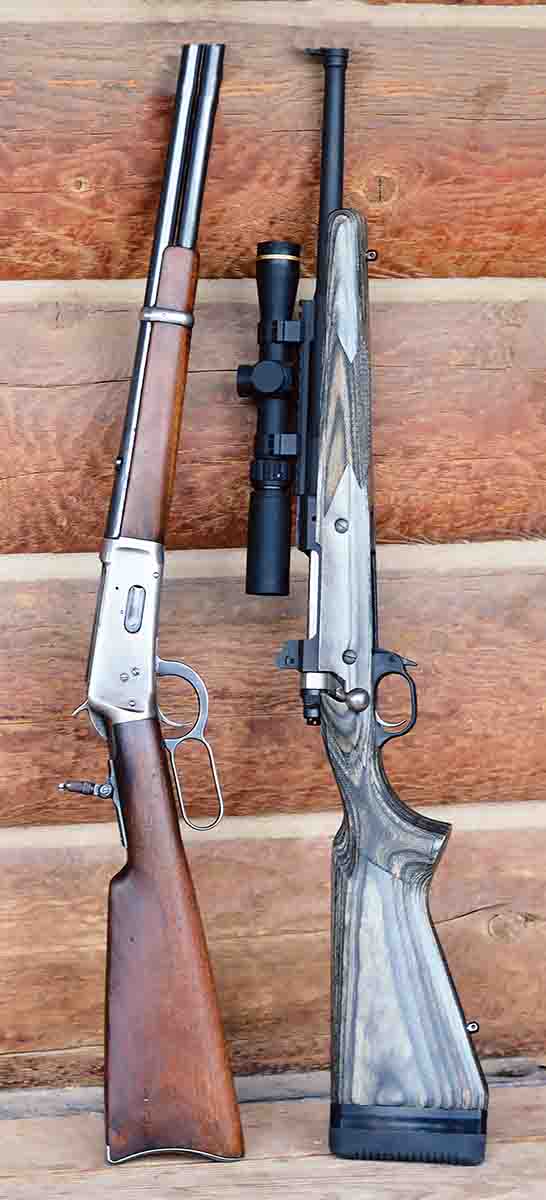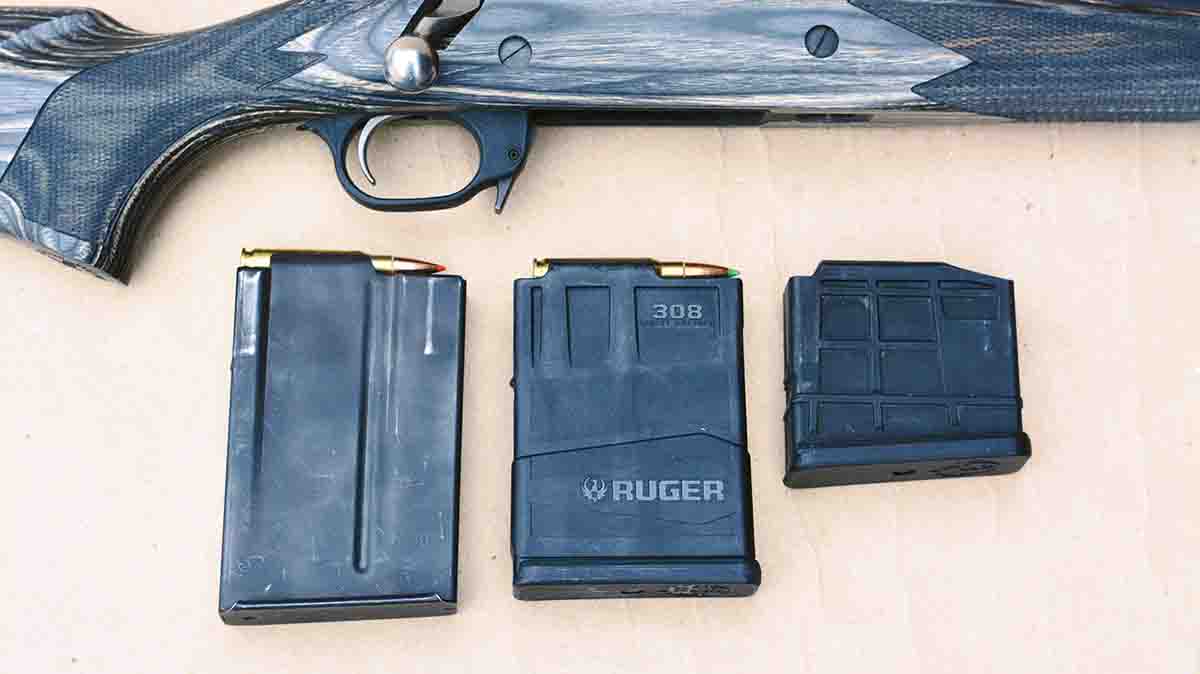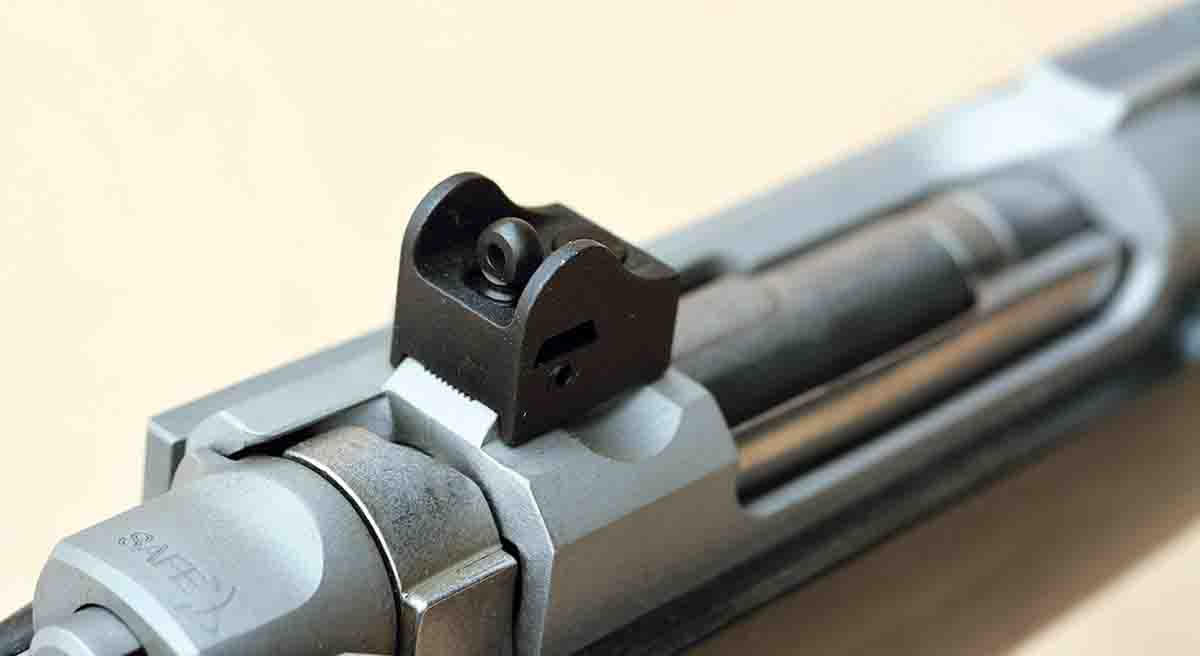Ruger Gunsite Scout .308 Winchester
A Versatile, Accurate, All-Purpose Rifle
feature By: Brian Pearce | March, 22



As strange as it may sound, one of the most influencing rifles was the Winchester Model 1894 carbine chambered in .30-30 Winchester, which also carries the unofficial title of being the world’s most popular sporting rifle. Even in his youth, while working at a large gun range, Cooper noted the handiness of this compact levergun and its ease of shooting targets offhand at 200 yards rather quickly. However, after a lifetime of military experience and training, he also recognized that greater power, accuracy and other notable features would serve to increase the rifle’s versatility and usefulness.
Cooper originally had several short-action, bolt-action rifles built (beginning in the 1980s) that were based on the Remington Model 600, Mauser 98 and other actions, including the Ruger M77. Naturally, he began writing about them. Cooper specifically wanted a cartridge that was capable of taking game up to 200 kilos (440 pounds), but ammunition must be available in practically every corner of the world. The .308 Winchester and 7.62 NATO cartridges (technically not identical, but in this application can be interchanged) seemed to fill this requirement better than any other cartridge. Having been developed in 1952 and serving as our military cartridge in the past 69 years, the .308/7.62 needs no introduction. However, it is truly a proven cartridge that offers consistent accuracy, long barrel life and can reach 1,000-yard targets with correct loads, and with modern hunting bullets, it will easily take game that is larger than Cooper’s specified 200 kilos.
Other Cooper scout rifle specifications included that overall rifle length should not exceed 39 inches and weigh around 6.6 pounds. The scope should be mounted with the eye box mostly forward of the action and would offer intermediate eye relief. This feature was intended to allow quick optic and target alignment, but also allow the shooter to better see surroundings with both eyes open, or, what military combatants refer to as “situation awareness.”

Ruger soon began working on a scout rifle; however, the project proceeded slowly until 2009 when it reached out to Gunsite Range Master, Ed Head, to co-develop what would become a truly outstanding rifle. Noted Ruger engineer Roy Melcher was pulled out of retirement for a second time to oversee the project.

The action of the Ruger Gunsite Scout rifle would be based on the Ruger M77 MKII/M77 Hawkeye (which are improved versions of the original M77) and are a most rugged and reliable action. While it shares many basic design features of the grand Mauser 98, there are also many technical departures. Suffice to say, it features twin forward locking lugs that offer strength while bolt lift is 90 degrees. This provides a relatively easy-to-open action, the swept bolt lifts with ease and the action operates smoothly. The Gunsite Scout features a non-rotating claw extractor, blade ejector and controlled-round feeding while the bolt body has an integral anti-bind lug. The wing-style safety is three-position that serves to lock the bolt close in the rearmost position, while the middle position allows the removal of a cartridge while keeping the firing pin blocked. The firing pin has significant mass for reliable primer ignition, but is also especially robust and very unlikely to break or fail.
The Ruger action features an excellent gas system that serves to protect the shooter in the unlikely event of a ruptured case, or worse. The receiver is cast from AISI 4140 chromoly steel and then machined to final form, all of which serves to keep costs in check. It is noteworthy that the steel grain structure of the cast receiver has proven to be stronger than conventional bar stock of the same steel. Regardless, destruction tests support that the Ruger 77 MKII and its variants are incredibly strong actions. Furthermore, the receiver features dual dovetail recesses that correspond with steel clamp-on scope rings, which results in a brutally strong scope mounting system.

.jpg)
For the first 20 rounds, the barrels of the two test rifles were cleaned and then lightly oiled after every two rounds, then cleaned after every 10 rounds for the next 30 rounds. Other than that, and checking guard screws to be certain that they were torqued to a factory specified 95 inch-pounds, the rifles were tested as they came from the box.
The front sight is post-style with protective “wings,” while the rear sight is a ghost ring-style aperture and is mounted directly to the receiver via the rear scope ring dovetail slot.

Test rifles included a blue finished version with 16.10-inch barrel and a stainless steel version with a 18.70-inch barrel. In testing more than a dozen different factory loads, the accuracy difference between the two rifles was difficult to detect. However, the stainless version had a slight edge. Nonetheless, the 16.10-inch version was accurate, with select premium loads grouping under an inch with loads from Hornady, Black Hills Ammunition, Nosler and HSM, and was the rifle used to establish accuracy and velocity of factory ammunition and handloads.

By carefully mating the correct components, handloads easily duplicated or exceeded the accuracy of factory loads. For example, using the Hornady 168-grain A-MAX bullet with 46 grains of Hodgdon Varget powder, four shots clustered under .75 inch from a very warm barrel! Switching to the Nosler 165-grain Ballistic Tip bullet mated with 47 grains of Alliant Reloder 15 powder, again four shots clustered under .75 inch, also fired from a warm barrel. The above loads were assembled in Starline cases and capped with a CCI BR-2 primer.
Every Ruger Gunsite Scout rifle that I have worked with has displayed reliable function and is more or less ready to go right out of the box. Their trigger pulls generally measure around 4 pounds, which is reasonable in today’s lawsuit happy society, and can be fired with reasonable accuracy. However, a qualified gunsmith can easily improve this trigger without compromising reliability.

With the popularity of the Ruger Gunsite Scout rifle, many accessories have become available that serve to help the rifle perform in more specialized roles. I have used Scout scopes from Leupold that I have been especially pleased with that include the VX-2 1.5-4x 28mm Scout and the VX-Freedom 1.5-4x 28mm. Both versions feature Leupold’s exceptionally tough construction; shockproof, waterproof, fogproof, etc., .25 MOA click adjustments, fully-coated optics that are lightweight and compact. Due to the 1.5x low power magnification, they are excellent choices for quick offhand shooting. On the other hand, when turned up to 4x magnification, they are capable of making hits at extended ranges of 400 and even 500 yards.

Back in the early 1980s, I had the pleasure of becoming friends with the late Bill Jordan. Bill was a World War II combat veteran, border patrolman, a top-notch hunter and a remarkable world-class shot with a sixgun, rifle and shotgun. It has been 40 years since he taught me the many virtues and potential of 1-4x, 1.5-4x and 1.5-5x and similar power rifle scopes. I have used them extensively on big game around the world and find that they offer extremely fast target acquisition when taking running game, but neither do I feel handicapped if distances are stretched to several hundred yards.
.jpg)
All of the above scopes are mounted in Leupold QRW rings that feature finger levers that permit their being removed and reinstalled without tools while still holding their zero.

Another sighting system that is worth considering includes reflex sights, which have become very popular, especially when a rifle is needed in low-light conditions and at close range. While there are some modestly priced versions that are good, it is money well spent to opt for high-quality versions that are rugged and reliable. One example includes the Trijicon MRO with an LED red dot that is brightness adjustable with eight settings for various light conditions. Furthermore, it offers a positive .25-MOA adjustment value (windage and elevation) while providing infinite eye relief so it can be mounted where desired on the Picatinny rail to retain Jeff Coopers “situation awareness” criteria. Trijicon uses 7075-T6 aluminum to construct the body, which along with proper engineering results in a military-grade, shockproof sight. It is lightweight (4.1 ounces), waterproof and boasts of a long battery (CR-2032) life. It is made in the U.S., so it is not surprising that it performed flawlessly in my testing and evaluation on a Gunsite Scout rifle.
While the factory Gunsite Scout scope and sight mounting system, including the barrel-mounted Picatinny rail, the receiver-mounted dovetail for direct scope ring mounting and aperture rear sight, is a very good and versatile setup. Another mount system that is worthy of consideration is the XS Sights Picatinny rail. This unit replaces the original Gunsite Scout aperture sight and Picatinny rail and measures approximately 11.5 inches long, but houses its own aperture ghost ring rear sight. Its advantages are that it will accommodate any cross-slot Picatinny mount at any reasonable position. In other words, scout-style scopes, reflex sights, etc., can be mounted as they are designed, but when mounting a traditional scope with conventional eye relief, it can be mounted where desired on the rail without removing the aperture rear sight, whereas the original Gunsite Scout rifle rear sight must be removed to install the Ruger scope rings into the dovetail mounts.

I have one Gunsite Scout rifle with the XS Sights rail that I have installed a Burris 2-7x 32mm Scout scope and a Leupold VX-3i LRP 4.5-14x 50mm Long Range Precision with a front focal plane. Both are mounted in Leupold QRW rings and can be changed in just seconds without tools. However, the Burris Scout scope is zeroed with my handloads containing the Nosler 165-grain Ballistic Tip bullet at 2,750 feet per second (fps), which is a fine general purpose deer hunting load; however, the Leupold VX-3i scope is zeroed for Hornady’s excellent 178-grain ELD-X bullet (2,600 fps) that will stay supersonic out to 1,325 yards and is a worthy long-range load. While there are better long-range rifles, this combination serves to increase the versatility of the Gunsite Scout rifle. Furthermore, I can remove both scopes to make the rifle a compact, lightweight saddle gun while employing the fully adjustable XS aperture sight. If there is a small disadvantage with the XS Picatinny rail, it would be that it bridges over the rifle’s ejection port, resulting in it being slightly smaller and less accessible. Nonetheless, I find great value in the XS Sights mount and sight system.
In addition to the classic and very versatile .308 Winchester, the Ruger Gunsite Scout is currently offered in .350 Legend and .450 Bushmaster (with 5.56 NATO and 6.5 Creedmoor being discontinued).
Scouts have played a vitally important role in U.S. history, and in many instances have saved lives, provided information that won battles and have often been considered heroes. Just like those scouts, the Ruger Gunsite Scout is truly reliable, rugged, accurate, versatile and can serve valiantly in many roles.



.jpg)